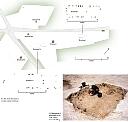It should not be assumed that this site is publicly accessible and it may be on private property. Do not trespass.
Monument details
Summary
During work on the Whitfield- Eastry bypass the remains of an early medieval settlement were found overlaying two earlier Iron Age sites (TR 34 NW 222 & 224). The site comprised a number of structures, two timber halls and a number of sunken huts. Pottery from the site was dated to c.575 - 700 AD.
Images

| Grid Reference: | TR 31362 45832 |
|---|
| Map Sheet: | TR34NW |
|---|
| Parish: | WHITFIELD, DOVER, KENT |
|---|
Monument Types
- GRUBENHAUS (Early Medieval or Anglo-Saxon - 575 AD? to 700 AD? (at some time))
- HAMLET (Early Medieval or Anglo-Saxon - 575 AD? to 700 AD? (at some time))
- PIT (Early Medieval or Anglo-Saxon - 575 AD? to 700 AD? (at some time))
- TIMBER FRAMED BUILDING (Early Medieval or Anglo-Saxon - 575 AD? to 700 AD? (at some time))
Associated Finds
- ANIMAL REMAINS (Early Medieval or Anglo-Saxon - 575 AD? to 700 AD?)
- BEAD (Early Medieval or Anglo-Saxon - 575 AD? to 700 AD?)
- BIRD REMAINS (Early Medieval or Anglo-Saxon - 575 AD? to 700 AD?)
- EGG SHELL (Early Medieval or Anglo-Saxon - 575 AD? to 700 AD?)
- FISH HOOK (Early Medieval or Anglo-Saxon - 575 AD? to 700 AD?)
- FISH REMAINS (Early Medieval or Anglo-Saxon - 575 AD? to 700 AD?)
- MOLLUSCA REMAINS (Early Medieval or Anglo-Saxon - 575 AD? to 700 AD?)
- PATERA (Early Medieval or Anglo-Saxon - 575 AD? to 700 AD?)
Full description
If you do not understand anything on this page please contact us.
During work on the Whitfield- Eastry bypass the remains of an early medieval settlement was found superimposed over two earlier iron age sites (TR 34 NW 222 & 224). The site consists of at least six buildings and pits in a 110-metre area.
There were two timber rectangular halls, post-holes badly damaged by ploughing, aligned ne-sw 55m apart with a sunken hut in between. This was the largest of the four sunken buildings found measuring 3.78 m by 2.95 m and showed clear marks of having been first excavated with an iron mattock. A pattern stake holes in the hut floor would have been successive replacements for a central partition or storage racks. Wet sieving of the fill from the hut produced fragments of animal bone, oyster shell, fish and bird bones, egg shell and grain. Small finds for the hut included two possible fishhooks and three glass beads. The hut seems to have been used as a rubbish pit when it went out of use.
The other three huts varied in size and in each case the base of the hut-pit represented the actual floor of the hut. Organically tempered pottery, animal bone and eggshell were recovered from these features.(1)
Additional references (2 -3).
<1> Canterbury Archaeological Trust, 1996, Whitfield-Eastry Bypass 1995: Assessment Report on Excavations at Site 2 (Church Whitfield Crossroad) (Unpublished document). SKE12079.
<2> Canterbury Archaeological Trust, 1994, A256 Whitfield to Eastry Improvement Road: Report on the Archaeological Evaluations 1994 (Unpublished document). SKE12037.
<3> Canterbury Archaeological Trust, 1994, 256 Whitfield to Eastry Improvement Road: Report on Archaeological Evaluations 1992-1993 (Unpublished document). SKE8356.
Sources and further reading
| Cross-ref.
| Source description | | <1> | Unpublished document: Canterbury Archaeological Trust. 1996. Whitfield-Eastry Bypass 1995: Assessment Report on Excavations at Site 2 (Church Whitfield Crossroad). |
| <2> | Unpublished document: Canterbury Archaeological Trust. 1994. A256 Whitfield to Eastry Improvement Road: Report on the Archaeological Evaluations 1994. |
| <3> | Unpublished document: Canterbury Archaeological Trust. 1994. 256 Whitfield to Eastry Improvement Road: Report on Archaeological Evaluations 1992-1993. |
Related thematic articles
